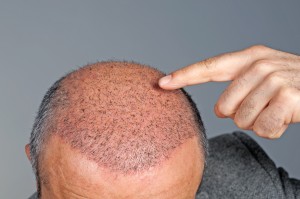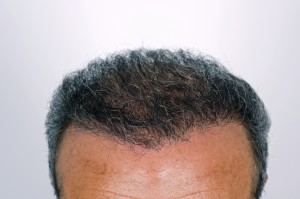
Hair loss is a common condition that affects up to 56 million Americans. It typically affects men beginning in their 40’s and post-menopausal women with a slight predominance towards men. There are many causes of hair loss including nutritional deficiencies, auto-immune disorders, trauma and most commonly genetic/hormonal predisposition. While hair loss is often joked about in our culture, the psychological effects on patients can be quite debilitating. Fortunately, there are a host of new advances that are making the management of this problem more effective.
From a prevention standpoint, optimizing one’s medical health and nutritional status can be very effective in reducing the most benign forms of hair loss. Autoimmune disorders can also be managed with certain off-label applications of approved medications. In men showing early signs of hair loss, preventive strategies such as Rogaine® and Propecia® can be helpful in slowing the rate of hair loss. Low-level laser brushes and caps have been shown to increase blood supply to the scalp and is a useful adjunct in preventing hair loss and in certain situations encouraging hair growth after transplantation. Other areas of active research include the injection of Platelet Rich Plasma in areas of hair loss or after hair transplantation to encourage hair growth. More futuristic options being investigated include stem cell transplantation of hair follicle cells to re-grow hair in previously bald spots.
Today, the “gold-standard” for the permanent treatment of hair loss is follicular unit hair transplantation. Gone are the days of un-natural looking hair plugs and in with mechanically assisted or robotic harvesting of individual hair follicles. These advances have made hair transplantation a very natural looking treatment alternative with minimal scarring. Hair follicles are individually harvested from an area of abundance and carefully transplanted to the desired area of hair loss. While the traditional strip harvesting method may still be necessary in some patients, the newer follicular unit extraction method is a virtually scar-less method that works in most patients. This treatment method can be used to treat hair loss on the scalp as well as other hair bearing areas such as the eye- brows, eye-lashes, mustaches and beards.
These procedures are performed in the comfort and privacy of the office under local anesthesia. Most patients can quickly return to regular activities and work without any stigma within 7-10 days of treatment. The downtime from this procedure is primarily social due to swelling and slight scabbing at the treatment sites. Hair growth is typically slow in the early months after treatment with optimal results achieved 6-12 months later. Large areas of hair loss or particularly dense hair patterns may require a second treatment. Recent advances in technology and techniques has made this treatment more effective than ever with shorter down time. Today, hair transplantation has become an increasingly viable and successful option for the permanent treatment of many forms of hair loss in men and women alike.
Hair Transplant Patient Hair Transplant Patient
10 days Post-operatively 6 Months Post-operatively

George Bitar, MD, FACS is an award-winning, board-certified cosmetic and reconstructive plastic surgeon, the Founder and Medical Director of Bitar Cosmetic Surgery Institute in Virginia. He specializes in the latest surgical and minimally invasive techniques to scar management and reduction. Dr. Bitar is involved in groundbreaking research and education in plastic surgery and has authored numerous articles, abstracts, and chapters.






